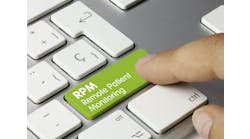The Chicago-based Northwestern Medicine is working with global heart health company Omron Healthcare, Inc. on a new pilot program to offer a remote patient monitoring service to high-risk hypertensive patients.
The solution from Omron, VitalSight, is a remote patient monitoring service that physicians can offer to patients with high risk levels of hypertension. Officials note that more than 37 million U.S. adults have uncontrolled Stage 2 hypertension that can contribute to increased risk of heart attack and stroke and may also lead to damage to arteries and organs such as liver, kidneys, heart if no treatment is administered.
VitalSight is designed to engage patients in active condition management. Patients receive a kit delivered to their home that includes an Omron connected blood pressure monitor and data hub that are pre-set and do not require WiFi. Thus, officials say, patients can securely share measurements with their physician and care team. What’s more, patients can immediately start monitoring their blood pressure and sharing their data with their clinicians.
VitalSight must be ordered by a healthcare provider and is available to patients at little to no cost and is reimbursable through Medicare, officials noted.
"The Omron VitalSight remote patient monitoring pilot program engages our patients to check their blood pressure at home and readings are sent directly to their physicians and health teams through the electronic medical record (EMR) system. As my patients check their blood pressure at home, their readings are sent to me automatically, allowing me to provide recommendations and adjust blood pressure medications in a timely manner," Jennifer Bussell, M.D., regional medical director, Northwestern Medicine, said in a statement.
"Omron remote patient monitoring empowers patients to know their blood pressure numbers and connects physicians with their patients. This real-time data allows the patient and physician to optimize control of the patient's blood pressure which can decrease the patient's risk of complications from poorly-controlled hypertension," added Bussell.
Leaders at Omron say that VitalSight was designed to provide more clinically relevant data to manage hypertension and improve patient health outcomes. They contend the service is unique given its ability to integrate patient data directly into the physician's EMR system or through the company’s “doctor dashboard” that is aimed to streamline clinician workflow. What’s more, doctors can personalize blood pressure reading thresholds for each patient and receive alerts for high readings through their EMR so care teams can take action and make more informed treatment decisions.
"Our mission is going for zero heart attacks and strokes and VitalSight is a key step forward to provide exceptional support to those struggling to manage their hypertension," said Ranndy Kellogg, president and CEO of Omron Healthcare. "Northwestern Medicine is a forward-thinking health system that shares our bold mission. This pilot will explore the benefits of VitalSight. Early feedback shows that VitalSight is quickly helping physicians improve engagement with patients on their treatment plans,” he stated.


